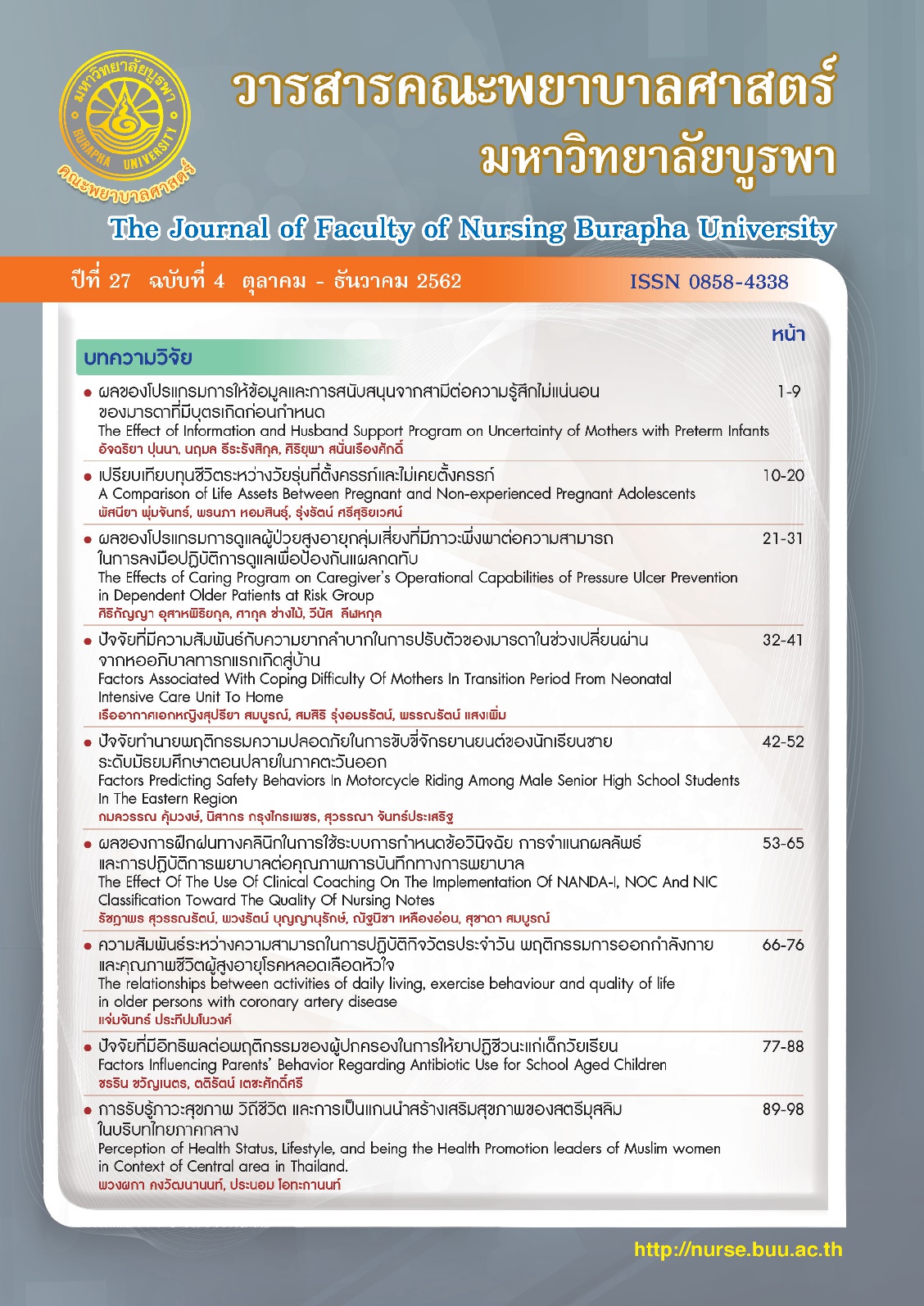ผลของโปรแกรมการดูแลผู้ป่วยสูงอายุกลุ่มเสี่ยงที่มีภาวะพึ่งพาต่อความสามารถ ในการลงมือปฏิบัติการดูแลเพื่อป้องกันแผลกดทับ
คำสำคัญ:
ความสามารถ, การลงมือปฏิบัติการดูแลของผู้ดูแล, การป้องกันแผลกดทับ, ผู้ป่วยสูงอายุบทคัดย่อ
บทคัดย่อ
การวิจัยครั้งนี้เป็นการวิจัยเชิงทดลอง เพื่อศึกษาผลของการใช้โปรแกรมการดูแลผู้ป่วยสูงอายุกลุ่ม เสี่ยงที่มีภาวะพึ่งพา กลุ่มตัวอย่างเป็นผู้ป่วยสูงอายุกลุ่มเสี่ยงที่มีภาวะพึ่งพาที่เข้ารับการรักษาในโรงพยาบาล ตติยภูมิแห่งหนึ่งในจังหวัดราชบุรี สุ่มเข้ากลุ่มทดลอง 28 ราย และกลุ่มควบคุม 28 ราย โดยกลุ่มทดลองได้รับ โปรแกรมการดูแลผู้ป่วยสูงอายุกลุ่มเสี่ยงที่มีภาวะพึ่งพาโดยผู้ดูแลมีส่วนร่วม ส่วนกลุ่มควบคุมได้รับการ พยาบาลตามปกติ เครื่องมือในการวิจัย ประกอบด้วยโปรแกรมการดูแลผู้ป่วยสูงอายุ แบบประเมิน ความสามารถในการปฏิบัติการดูแลเพื่อป้องกันการเกิดแผลกดทับ แบบประเมินความเสี่ยงด้านร่างกายต่อการ เกิดแผลกดทับของบราเดน และแบบประเมินการเกิดแผลกดทับของ Bergstrom เคราะห์ข้อมูลด้วยสถิติเชิง พรรณนา สถิติที และสถิติไคสแควร์
ผลการวิจัยพบว่า ค่าเฉลี่ยคะแนนความสามารถในการดูแลของผู้ดูแลเพื่อป้องกันแผลกดทับใน ด้านการดูแลผิวหนังและการรักษาความสะอาด การช่วยเหลือด้านการเคลื่อนไหว และการดูแลเรื่องอาหาร และน้ำของกลุ่มทดลอง ดีกว่าก่อนได้รับโปรแกรม และดีกว่ากลุ่มควบคุมอย่างมีนัยสำคัญทางสถิติ (p< .05) นอกจากนี้ยังพบว่า อุบัติการณ์การเกิดแผลกดทับในผู้ป่วยสูงอายุกลุ่มเสี่ยงที่มีภาวะพึ่งพาของกลุ่มทดลอง น้อยกว่าในกลุ่มควบคุม มีนัยสำคัญทางสถิติ (p< .05) การวิจัยครั้งนี้แสดงให้เห็นว่าโปรแกรมการดูแลนี้สามารถช่วยลดอุบัติการณ์การเกิดแผลกดทับในผู้ป่วยสูงอายุกลุ่มเสี่ยงที่มีภาวะพึ่งพาได้ ดังนั้นควรส่งเสริมให้ผู้ดูแลผู้สูงอายุกลุ่มเสี่ยงที่มีภาวะพึ่งพามีความรู้และมีความสามารถในการลงมือปฏิบัติการดูแลเพื่อป้องกันแผลกดทับในด้านการดูแลผิวหนังและการรักษาความสะอาด และการดูแลเรื่องอาหารและน้ำ
เอกสารอ้างอิง
Tapanon, P. (2007). The effects of a continuing care program for pressure sore prevention among high-risk patients. Journal of Nursing Science, 14(1), 63-72. [In Thai]
Tonsook, P. (2010). The effects of promoting family cares skill program on the incidence of pressure ulcer in order people with post abdominal surgery. Journal of
Gerontology and Geriatric Medicine, 12(3), 1-9. [In Thai]
Atsantachai, P. (2003). Pressure ulcer in the elderly. Bangkok: PA living. [In Thai]
Chawalitsupasearani, P. (2010). Comparison of pressure ulcer risk factor and caregiver’s capability on prevention of pressure ulcer development among hospitalized stroke patients. Master of Nursing Science Thesis, Faculty of Nursing,
Songklanakarint University. [In Thai]
Ratchburi Hospital. (2017). Report of health statistics and quality control. Ratchburi: Ratchburi Hospital. [In Thai]
Braden, B. & Bergstrom, N. (2000). A conceptual schema for the study of etiology of pressure sore. Rehabilitation Nursing, 25(3), 105-109.
Cavalcante, T.B., Moura, E.C., & Luz MHBA. (2016). Updating PF the assistance protocol for pressure ulcer prevention. Journal of Nursing, 10(3), 1498-1506.
Das, Supriya. (2013). Effectiveness of structured teaching program on prevention and management of pressure ulcer for caregivers of hospitalized immobilized patients. International Journal of Nursing Education, 5(1), 181-183.
De Oliveira Matos, S.D., Marques Andrade de Souza, A.P., Silva de Aguiar, E.S., Alves da Silva, M., Guimarães Oliveira Soares, M.J., & dos Santos Oliveira, S.H. (2016). Pressure sore prevention: Knowledge of formal caregivers of Institutionalized elderly people. Journal of Nursing, 10(11), 3879-3874.
Gorecki, C., Brown, J.M., Nelson E.A., Briggs, M., Schoonhoven, L., Dealey, C., Nixon, J. (2009). Impact of pressure ulcers on quality of life in older patients: a systematic review. Journal of the American Geriatrics Society, 57(7), 1175-1183.
Kalowes, P. (2016). Five-layered soft silicone foam dressing to prevent pressure ulcers in the intensive care unit. American Journal of Critical Care, 25(6), E108-E119.
Lewis, C.B. & Bottomley, J.M. (2008). Geriatric rehabilitation: A Clinical approach (3rded.). Washington DC: Upper Saddle River.
National Decubitus Foundation. (2002). Cost saving through bedsore avoidance. Retrieved on 24 September 2017, from http://www.Decubitus.org
National Pressure Ulcer Advisory Panel, European Pressure Ulcer Advisory Panel and Pan Pacific Pressure injury alliance. (2016). Prevention and treatment of pressure ulcer: Clinical practice guideline. Hacsler (Ed). Cambridge media Perth Australia.
Orem, D.E., Talor, S.G. & Renpenning, K.M. (2001). Nursing: Concept of practices. St. Louis: Mosby.
Pittman, J. (2007). Effect of aging on wound healing current concept. Journal Wound Ostomy Continence Nursing. 34(4), 412-415.
Tayyib, N., & Coyer, F. (2016). Effectiveness of Pressure Ulcer Prevention Strategies for Adult Patients in Intensive Care Units: A Systematic Review. Worldviews on Evidence-Based Nursing, 13(6), 432-444.
Young, T. & Clark, M. (2009). Re-positioning for pressure ulcer prevention. The Cochrane Library, 4.





